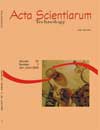Photocatalytic degradation of textile effluents using TiO<sub>2</sub> and Nb<sub>2</sub>O<sub>5</sub>, under visible irradiation
DOI:
https://doi.org/10.4025/actascitechnol.v24i0.2499Keywords:
fotodegradação, irradiação visível, TiO2, , Nb2O5Abstract
This research aims to work with photocatalysis as an alternative in the treatment of textile wastewater, because of the unsatisfactory degradation of some dyes by the conventional biological methods. Photocatalytic degradation tests were done in three natural textile effluents, under visible irradiation. The photocatalysts used were: TiO2 and Nb2O5, pure and combined with mechanical mixture (1:1) and impregnation (5% Nb2O5/TiO2). The characterization analysis (TPR, DRS, acidity, FTIR and textural analysis) indicated a synergic effect and differentiated interaction between the oxides and the formation of a new phase in the catalystic Nb2O5-TiO2. Decolorization and mineralization results showed that the color reduction is not directly related to the COD reduction and that the efficiency of the photocatalytic process depends on both, the effluent to be treated and the photocatalyst worked, showing that the use of Nb2O5 and visible irradiation on the photo degradation of the textile effluents is promising.Downloads
Download data is not yet available.
Downloads
Published
2008-04-22
How to Cite
Santana, V. S., & Machado, N. R. C. F. (2008). Photocatalytic degradation of textile effluents using TiO<sub>2</sub> and Nb<sub>2</sub>O<sub>5</sub>, under visible irradiation. Acta Scientiarum. Technology, 24, 1681–1686. https://doi.org/10.4025/actascitechnol.v24i0.2499
Issue
Section
Chemical Engineering
License
DECLARATION OF ORIGINALITY AND COPYRIGHTS
I Declare that current article is original and has not been submitted for publication, in part or in whole, to any other national or international journal.
The copyrights belong exclusively to the authors. Published content is licensed under Creative Commons Attribution 4.0 (CC BY 4.0) guidelines, which allows sharing (copy and distribution of the material in any medium or format) and adaptation (remix, transform, and build upon the material) for any purpose, even commercially, under the terms of attribution.
Read this link for further information on how to use CC BY 4.0 properly.











8.png)




